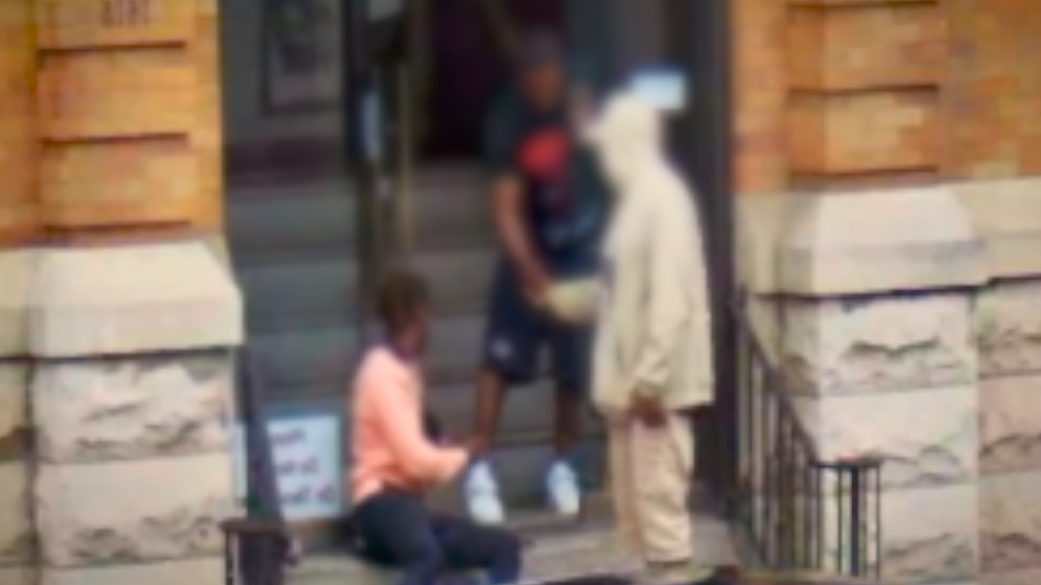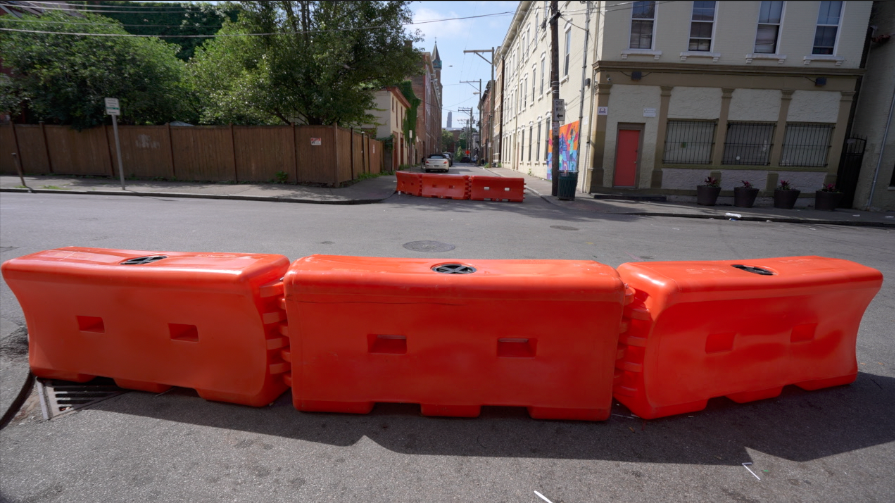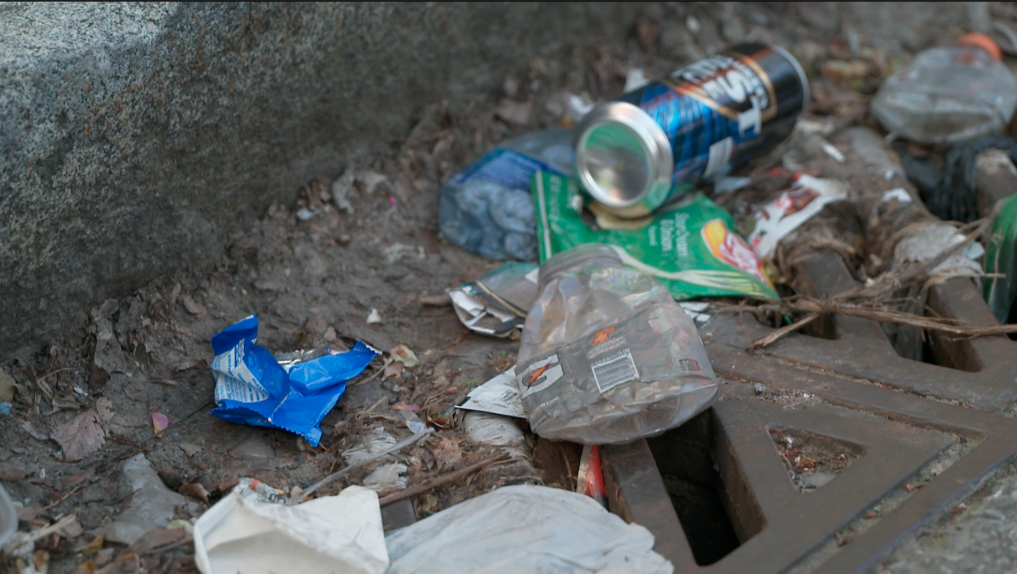CINCINNATI — Leaders of a historic Over-the-Rhine church may install fencing across its steps to discourage crowds as Cincinnati police try to stabilize a neighborhood troubled with violent crime and open-air drug dealing.
“It has become a lot worse in probably the last three years,” said Brother Tim Sucher, assistant pastor of St. Francis Seraph Church. “Sometimes we can have 60 to 70 people out on this plaza.”
The church, which will celebrate its 165th birthday in December, is known for its basement burial crypts and as the original site of the oldest Catholic church in the Greater Cincinnati area. But its tree-shaded plaza at Liberty and Vine streets has also become synonymous with parties, crowds and free food giveaways — especially in the summer months.
“These people are not homeless … they pull up in their cars and they pull out their lawn chairs and their coolers, bring their children,” Sucher said. “This has become like a park.”

Police are targeting the neighborhood north of Liberty Street as a PIVOT program, which is meant to address small areas of chronic violence.
Because of the church’s popularity as a gathering spot, its role in the neighborhood has come into the spotlight.
Capt. Matthew Hammer said church leaders and police have begun a “joint problem-solving effort,” regarding issues at church property and in the immediate vicinity. Representatives from City Manager Sheryl Long’s office met with St. Francis Seraph leaders on July 8.
“They believe our church should be a church and not a place for social services,” Fr. Al Hirt wrote in a recent church bulletin. “New NO TRESPASSING signs will be posted … larger signs will say NO DRINKING, NO DRUGS, NO PARTIES, NO LOITERING etc. The goal now is to have no one loitering in front of the church at any hour.”
For eight years the church welcomed the homeless inside to sleep in pews, eat, pray and use bathrooms for up to eight hours each day. But in late March, the church locked its doors to the homeless and put up no trespassing signs due to lack of funding for security guards, which could cost up to $10,000 a month.
The parish is not abandoning its mission to serve the homeless. Instead of using the church for outreach, it will rely on St. Francis Seraph Ministries, which offers a soup kitchen, foot care and other services, Sucher said.

“The goal is to make this not an outreach center, not a place where people can come and get rest and all that,” Sucher said. “This is going to be a church. Period.”
Many parishioners are shielded from the crowd problems, he said, “because by the time they come here for Mass on Sundays, everybody has moved out and we’ve cleaned up the place. They don’t really feel the full impact of what goes on during the week.”
“There are people who live here in the neighborhood, who are part of the neighborhood, who are also embarrassed by what’s going on here,” said Sucher, who admitted that parishioners realized that something had to change about a month ago.
Church leaders plan to install surveillance cameras at the front and side of its buildings.
“I’m going to recommend that we fence off just the steps. I think that would deter a lot of people because we can’t be out here all day long enforcing rules and regulations,” Sucher said. “I can’t do it. I don’t want to do it.”
The WCPO 9 I-Team obtained video of apparent drug deals taking place on the friary steps and inside the glass door. After a recent police drug bust there, the steps were empty this week.

“I am aware of a recent incident where drug activity was suspected to have occurred inside the side door of the church,” Hammer said. “Officers chased two suspects and apprehended one during this investigation. That individual was charged with drug trafficking, drug possession, resisting arrest, obstructing official business and several other offenses.”
North Over-the-Rhine has a reputation for crime and drug trafficking, which draws people from other parts of the city, Hammer said in an April interview.
Police installed temporary barriers just north of Green Street at Republic Street, and south of Green at Republic, in May to block through traffic and reduce the drive-by drug dealing.
The street closure is part of a broader strategy that Hammer said is showing early signs of improvement.
“My observations lead me to believe that we are making important progress. I have heard from community members nearby who agree,” he said.

“I certainly understand that problems persist and that some residents remain unhappy. More work is necessary,” Hammer said. “I also have heard from people both in proximity to St. Francis Church and near Republic and Green that feel much progress has occurred recently.”
Sucher applauded the city for recently removing a problem bus shelter on Vine Street across from the church, and installing no parking signs to allow for towing of cars where drugs and weapons may be stashed.
“You don’t see the amount of people hanging out there as we once did,” Sucher said about the street blockade on Republic Street. “I think for drug trafficking that’s a big deterrent because you can’t get out of there real fast.”
Despite a double shooting on July 13th that left one person dead at the corner of Vine and Green streets, Hammer said violent crime in OTR is down 15% from last year.

“Hot spot proactive patrolling continues in the areas of concern, as do problem-solving efforts through OTR PIVOT, and supplementary Republic/Green and St. Francis projects,” Hammer said. “Arrest activity this year-to-date shows 349 individuals arrested in OTR, charged with approximately 900 offenses; 664 traffic citations have been issued.”
But residents still complain about trash, illegal dumping, unpermitted food being cooked and sold on sidewalks, and a rat problem in the neighborhood.
“The City’s Health Department has worked with community stakeholders to address rodent and trash issues (specifically rats), and it is a regular partner with police in ensuring that vending/grilling/food sale conforms with regulations,” Hammer said.

The city manager’s office is now focused on the church and nonprofit groups that serve food and give away clothing in front of St. Francis, especially on Saturdays.
“One Saturday I was out here and there were three different groups that came like continuously,” Sucher said. “That draws people here and it also creates a lot more trash. Now the city manager’s office is working to contact these groups that are coming out here to encourage them to serve in another place.”
Sucher spends up to an hour spend cleaning after a big crowd leaves, picking up beer cans, Styrofoam food containers and unwanted clothing from giveaways.
While Sucher is hopeful that the crowds will eventually leave, he wonders where people will go.

“Someday, somebody is going to walk through Over-the-Rhine and say, ‘Look how we changed this place,’” Sucher said. “No, you didn’t change it. You just moved it somewhere else.”
He doesn’t think north Over-the-Rhine will stabilize until it is developed, just as new restaurants, bars and nightlife transformed the area south of Liberty Street a few years ago.
“When gentrification starts, and I am not opposed to gentrification because the city has got to expand its tax base in order to survive,” Sucher said. “What I’m opposed to is … they don’t plan for — where are people going to go when they’re not down here? Where are people going to live when they can’t live in this area anymore.”
When WCPO asked where the crowds would move to, Sucher said, “They’ll keep going up Vine Street, I’m sure.”
Adam Koehler lives just off Vine Street in Mt. Auburn, less than a 10-minute walk from St. Francis. He already worries about crime and drug dealing in his neighborhood and doesn’t want it to get worse when police push the problems out of north Over-the-Rhine.

“You never know what’s going to happen. At night we hear gunshots,” Koehler said. “We’ve had a bullet come through our bedroom window, just a random stray bullet,” Koehler said.
He wants the city to invest in better infrastructure in troubled neighborhoods, like Inwood Park’s crumbling buildings near his home, and for police to make proactive arrests.
“If I wanted to show people the bad part of Cincinnati … I’d just drive them up Vine Street. Up from Liberty all the way up here to Clifton,” Koehler said. You can see the dilapidated buildings, you can see the roads are in trouble, the trash, there are weeds growing out of sidewalks, cracks everywhere, abandoned buildings, and then you’ve got people sleeping in the building because there’s zero accountability.”
He feels as if elected leaders don’t care about these communities, and residents feel trapped because they are scared to stay, but can’t afford to leave.
“Pushing crime, pushing people around — that doesn’t solve any problems. You’re essentially just putting a Band-Aid on the problem,” Koehler said. “What happens to the people that have been down here for generations? They’ve got to go somewhere.”









